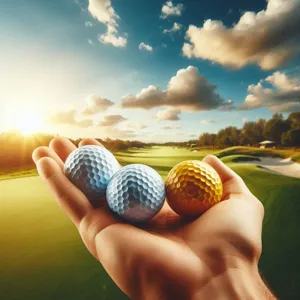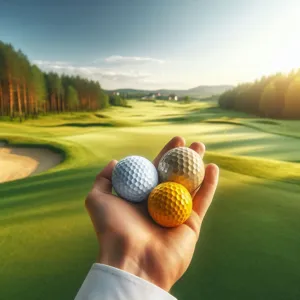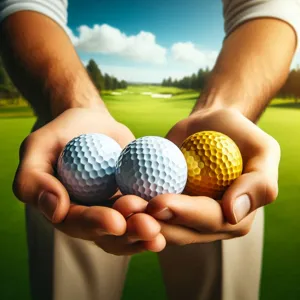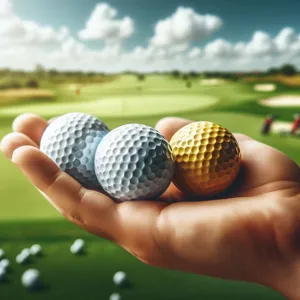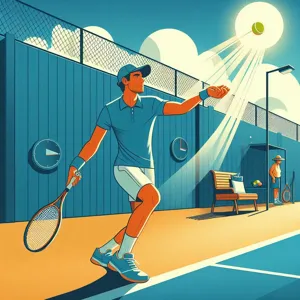Golf is a game of precision, skill, and strategy, and one of the most critical factors influencing your performance on the course is the golf ball you choose.
With a wide array of options available, from distance balls to spin-focused models and everything in between, selecting the right golf ball can feel overwhelming. Each type of golf ball is designed with specific features to complement different playing styles, swing speeds, and conditions, making it essential to find the perfect match for your game. In this ultimate guide to golf ball types, we’ll explore the various categories of golf balls, their unique characteristics, and how they can impact your performance on the course. Whether you’re a seasoned pro looking to fine-tune your game or a novice eager to enhance your skills, understanding the nuances of golf balls will empower you to make informed decisions and elevate your game to new heights. Get ready to tee off with confidence as we navigate the world of golf balls together!
1. Introduction to Golf Balls: Understanding the Basics

When it comes to the game of golf, the golf ball is more than just a small, dimpled sphere; it’s a crucial piece of equipment that can significantly impact your performance on the course. Understanding the basics of golf balls is essential for any golfer, whether you’re a seasoned pro or a weekend warrior.
Golf balls come in various types, each designed with specific characteristics that cater to different playing styles, skill levels, and swing speeds. At their core, golf balls are typically made up of two key components: the core and the cover. The core, often made of rubber or a similar material, is responsible for the ball’s feel and distance. The cover, made from materials like Surlyn or urethane, affects how the ball interacts with the clubface, influencing spin, control, and overall performance.
As you delve into the world of golf balls, you’ll encounter terms like “two-piece,” “three-piece,” and “multi-layer,” each denoting different construction methods that affect the ball’s flight and feel. For instance, two-piece balls are generally more durable and offer enhanced distance, making them a popular choice for beginners. In contrast, three-piece and multi-layer balls provide greater spin and control, appealing to more experienced players who prioritize precision around the greens.
In this guide, we will explore the various types of golf balls available, highlight their distinct features, and help you determine which one aligns best with your game. By the end, you’ll have a clearer understanding of how to select the perfect golf ball that not only complements your swing but also enhances your overall playing experience. Whether you’re seeking distance, control, or feel, the right golf ball is waiting to be discovered. Let’s tee off this journey into the fascinating world of golf ball types!
2. The Anatomy of a Golf Ball: What Makes It Unique
Understanding the anatomy of a golf ball is essential for selecting the right type that complements your game. At first glance, a golf ball may appear simple, but its unique construction plays a crucial role in performance.
A standard golf ball consists of several key components: the core, the cover, and the dimples.
At the heart of every golf ball is the **core**, which can vary in material and construction. Most modern golf balls feature a rubber or synthetic core that can either be single or multi-layered. A softer core typically provides increased clubhead speed and distance, making it ideal for beginners or those with slower swing speeds. In contrast, a firmer core can deliver enhanced control and spin, appealing to more advanced players looking to finesse their shots around the green.
Encasing the core is the **cover**, which significantly influences how the ball interacts with the clubface. Golf ball covers are usually made from either Surlyn or urethane. Surlyn covers are more durable and provide a lower spin rate, ideal for distance-focused players, while urethane covers offer a softer feel and higher spin, making them perfect for those who prioritize control and greenside performance.
Perhaps the most distinctive feature of a golf ball is its **dimples**. These small indentations, usually ranging from 300 to 500 in number, are meticulously designed to improve aerodynamics. Dimples create turbulence in the air surrounding the ball, reducing drag and allowing for a higher trajectory and increased distance. The size, shape, and pattern of the dimples can greatly affect how the ball flies through the air, adding another layer to the decision-making process when choosing the right ball for your specific swing style and conditions of play.
By breaking down these fundamental components, you can better appreciate how each element of a golf ball can impact your game. Whether you’re seeking distance, control, or a balance of both, understanding the anatomy of a golf ball is the first step in making an informed choice that will elevate your performance on the course.
3. Types of Golf Balls: A Comprehensive Overview

When it comes to choosing the right golf ball, understanding the different types available is crucial to enhancing your game. Golf balls can generally be categorized into three main types: **two-piece, three-piece, and four-piece**. Each type is designed to deliver distinct performance characteristics, catering to various skill levels and playing styles.
**Two-Piece Golf Balls** are the most common and affordable option on the market. Comprising a solid core encased in a durable cover, these balls are ideal for beginners or casual players looking for maximum distance and durability. The straightforward construction minimizes spin, making them forgiving on mis-hits while providing a straight trajectory. If you’re just starting out or primarily play recreationally, a two-piece ball might be your best bet.
**Three-Piece Golf Balls** introduce an additional layer, typically made of a softer material, which enhances feel and control around the greens. This type strikes a balance between distance and spin, making it a popular choice among mid-handicap players. The outer cover of these balls is designed for greater responsiveness, allowing for better performance on approach shots and short games. If you’re aiming to improve your precision while still benefiting from distance, consider giving three-piece balls a try.
**Four-Piece Golf Balls** represent the pinnacle of performance technology. With a complex construction that includes multiple layers, these balls are engineered for exceptional control, spin, and distance. The inner core is designed for maximum energy transfer during impact, while the outer layers help to manage spin on different shots. This makes four-piece balls an excellent choice for low-handicap players and seasoned golfers who demand the highest level of performance. If you’re serious about your game and want to elevate your skills, investing in a quality four-piece ball could be the key to unlocking your potential.
Additionally, within these categories, you’ll find various specialized golf balls designed for specific conditions or player preferences, such as low-compression balls for slower swing speeds or high-visibility options for enhanced tracking. Understanding the nuances of each type will empower you to make an informed decision that aligns with your unique playing style and objectives on the course. As you explore the different golf ball options, consider how each type complements your game and experiment to discover which one truly feels right for you.
4. Two-Piece vs. Three-Piece Golf Balls: Key Differences
When it comes to selecting the perfect golf ball for your game, understanding the differences between two-piece and three-piece golf balls can significantly influence your performance on the course. These two types of golf balls are designed with distinct constructions that cater to various playing styles and skill levels.
**Two-Piece Golf Balls**
Typically favored by beginners and those seeking maximum distance, two-piece golf balls are made with a solid rubber core encased in a durable cover, usually crafted from ionomer. This construction allows for a high initial velocity, resulting in impressive distance off the tee. The simplicity of the two-piece design also contributes to a lower price point, making these balls an economical choice for players who may lose a few during the round. However, while they excel in distance, their softer feel and limited spin may not provide the control and feedback that more experienced players desire, particularly around the greens.
**Three-Piece Golf Balls**
In contrast, three-piece golf balls offer a more complex construction, featuring a core, a layer of rubber or a similar material for added softness, and an outer urethane cover. This combination allows for greater spin control and a softer feel upon impact, which is essential for players looking to refine their short game. The additional layer also means that three-piece balls can provide a more responsive feedback, enabling skilled golfers to gauge their shots more accurately. While they typically come at a higher price point, the performance benefits can be well worth the investment for those who are serious about improving their game.
Ultimately, the choice between a two-piece and three-piece golf ball boils down to your playing style, skill level, and specific needs on the course. Whether you prioritize distance and affordability or control and feel, understanding these key differences will help you make an informed decision, ensuring that you have the right equipment to elevate your game.
5. Understanding Compression Ratings and Their Impact

When it comes to selecting the perfect golf ball for your game, understanding compression ratings is essential. Compression refers to how much a golf ball deforms when struck by a club, which in turn affects its performance characteristics. Golf balls are typically categorized into three main compression ratings: low, medium, and high. Each type is designed to cater to different swing speeds and playing styles, making it crucial to choose a ball that complements your unique game.
A low-compression ball, typically rated between 70 and 80, is ideal for golfers with slower swing speeds, generally below 85 mph. These balls are softer and compress more easily upon impact, allowing for increased distance and a higher launch angle. For players who tend to struggle with distance, opting for a low-compression ball can help maximize yardage while providing a softer feel around the greens.
Conversely, medium-compression balls, usually ranging from 80 to 90, strike a balance between distance and control. These balls are suitable for a wide array of players, including those with moderate swing speeds (85 to 100 mph). They offer a nice balance of feel and feedback, making them a versatile choice for golfers looking to enhance their overall performance without sacrificing too much distance.
High-compression balls, rated above 90, are designed for players with faster swing speeds, typically exceeding 100 mph. These balls are firmer and provide less deformation upon impact, allowing for better energy transfer and control over distance. For serious golfers seeking precision and accuracy in their shots, high-compression balls can deliver the performance needed to tackle the demands of the game.
Understanding these compression ratings and how they impact your gameplay is vital. Experimenting with different types can lead to significant improvements in both distance and accuracy. Remember, the right golf ball can make all the difference, so take the time to assess your swing speed and playing style to find the perfect fit for your game. With the right compression rating, you’ll be one step closer to lowering your scores and enjoying the game even more!
6. The Importance of Cover Materials: Surlyn vs. Urethane
When it comes to selecting the right golf ball for your game, understanding the importance of cover materials is essential. The two primary types of cover materials used in golf balls are Surlyn and urethane, each offering distinct characteristics that can significantly affect your performance on the course.
**Surlyn** is a tough, durable material that is often utilized in the construction of mid-range to budget-friendly golf balls. Its resilience makes it highly resistant to cuts and scuffs, which is ideal for golfers who prioritize durability over spin. Surlyn-covered balls typically have a firmer feel and provide a straighter flight path, making them a popular choice for beginners or those who tend to lose golf balls frequently. If you’re looking for a ball that can withstand the rigors of regular play while still delivering decent distance, Surlyn is a reliable option.
In contrast, **urethane** is a softer, higher-performance material that is favored by skilled players seeking enhanced control and feel around the greens. Urethane-covered golf balls are designed to offer increased spin, allowing for better shot shaping and stopping power on the greens. This added spin is particularly beneficial for players who enjoy making delicate approach shots and require precise control when chipping or putting. While urethane balls may wear down faster than their Surlyn counterparts, the trade-off is often worth it for those who value performance and finesse in their game.
Ultimately, the choice between Surlyn and urethane should align with your personal playing style and skill level. If you’re just starting out, a Surlyn-covered ball may be the best choice to help you develop your swing without the worry of excessive wear and tear. Conversely, if you’ve honed your skills and are looking to take your game to the next level, opting for a urethane ball can provide the added control and responsiveness that experienced players crave. By understanding the differences between these cover materials, you can make an informed decision that enhances your overall golfing experience.
7. Performance Characteristics: Distance, Control, and Spin

When it comes to selecting the right golf ball, understanding the performance characteristics of distance, control, and spin is essential to elevate your game. Each of these attributes plays a pivotal role in how the ball interacts with your club and the course, ultimately influencing your performance on the green.
**Distance** is often at the forefront of every golfer’s mind. Typically, distance is achieved through a combination of ball construction and compression. Two-piece balls, for example, are designed specifically for maximum distance, featuring a hard outer cover and a solid core that promotes a higher launch and reduced spin. This setup is ideal for beginners or those with slower swing speeds who want to gain extra yards off the tee. Meanwhile, more advanced players might opt for multi-layered balls that provide a balance of distance and control, allowing for longer drives without sacrificing performance on approach shots.
**Control** is crucial for precision shots, especially when navigating tricky lies or approaching the green. Golf balls with softer covers, such as urethane, offer superior control and feel, making them perfect for experienced players who prioritize shot accuracy. These balls allow for greater feedback on impact, giving you the confidence to shape your shots and tackle challenging pin placements. When selecting a ball for control, consider how it feels during your short game. A ball that provides a soft touch can help you execute delicate chips and putts with greater finesse.
**Spin**, on the other hand, is all about the ball’s ability to grip the clubface and create friction. Higher spin rates are beneficial for players looking to stop the ball quickly on the greens, especially with wedges. However, excessive spin can lead to a loss of distance due to ballooning shots. Golfers should find a balance that suits their style of play; for instance, a golfer who tends to hit the ball high might prefer a lower-spinning ball to maintain distance, while a player with a flatter trajectory might benefit from a higher spinning option to enhance control around the greens.
In summary, the ideal golf ball for your game hinges on your unique playing style and objectives on the course. By understanding the intricacies of distance, control, and spin, you can make an informed decision that not only complements your existing skills but also supports your journey toward improvement. Whether you’re a weekend warrior or a seasoned pro, investing time in selecting the right ball can make all the difference in your performance and enjoyment of the game.
8. How to Choose the Right Golf Ball for Your Skill Level
When it comes to selecting the ideal golf ball, understanding your skill level is crucial. The right ball can significantly enhance your performance on the course, allowing you to maximize distance, control, and spin based on your unique playing style. Here’s a breakdown of how to choose the perfect golf ball tailored to your experience and proficiency.
**Beginner Level:** If you’re just starting out, opt for a two-piece golf ball. These balls are designed for distance and are often more forgiving on mishits. They feature a softer cover and a larger core, which helps to increase ball speed and reduce spin, making it easier to achieve straighter shots. Look for brands that offer lower compression ratings—these will be easier to compress upon impact, resulting in better distance for slower swing speeds.
**Intermediate Level:** As your skills progress, you might want to consider a three-piece ball. These balls provide a balance of distance and control, incorporating a firmer cover that allows for better spin and feel around the greens. With a moderate swing speed, you’ll appreciate the added performance benefits, especially when it comes to approach shots and short game finesse. Seek out balls that offer a mix of distance and greenside control to elevate your game.
**Advanced Level:** For seasoned golfers, a multi-layered golf ball is your best bet. These balls typically feature a soft urethane cover that promotes exceptional spin and control, allowing for precise shots and enhanced feedback on every swing. If you have a fast swing speed, look for balls with higher compression to maximize distance while maintaining optimal spin for short game shots. At this level, you may also want to explore specialized options tailored to your playing style, whether it’s for added control on the greens or explosive distance off the tee.
Ultimately, the right golf ball can make a noticeable difference in your game. Consider testing a few different types to identify what works best for your swing and playing style. Remember, the journey to finding the perfect golf ball is as much about personal preference as it is about performance—so enjoy the process and watch your game flourish!
9. Golf Balls for Beginners: Finding the Right Fit
Choosing the right golf ball as a beginner can significantly impact your game, and it’s essential to understand what options are available to make an informed decision. As a novice, your primary goal is likely to develop your skills without becoming overwhelmed by the complexities of the game—and the right ball can help you achieve that.
Beginner golfers should look for balls that offer a combination of distance, forgiveness, and feel. **Two-piece balls** are often the best choice for newcomers. These balls typically feature a solid core and a durable cover, providing a good balance of distance and control. The solid core helps maximize distance on each shot, which is crucial for beginners still developing their swing speed. Additionally, the simpler construction of two-piece balls means they tend to be more affordable, allowing you to practice without worrying about the cost.
Another key consideration is the **compression** of the golf ball. Beginners often benefit from lower compression balls, which are softer and designed to compress more easily upon impact. This feature allows for better energy transfer, giving you added distance even if your swing isn’t yet perfectly refined. These balls also provide a more forgiving feel on mishits, which can help build confidence as you learn to play.
In addition to performance, don’t forget about the importance of **visibility**. Many beginners find it helpful to play with brightly colored or high-visibility balls, especially on the course where spotting a ball can sometimes be a challenge. Colors like neon yellow or orange can stand out against various terrains, making it easier to track your shots.
Ultimately, the best approach is to experiment with different types of golf balls to see which suits your game and preferences. Many golf retailers offer trial packs that allow you to sample several brands and models before committing to a bulk purchase. Remember, the right golf ball can enhance your experience on the course, making each round more enjoyable as you refine your skills and gain confidence in your game.
10. Golf Balls for Advanced Players: Maximizing Performance
For advanced players, selecting the right golf ball is not just about personal preference; it’s about maximizing performance on the course. At this level, golfers typically seek balls that offer superior control, enhanced spin, and exceptional distance, all while maintaining a soft feel around the greens.
Tour-level balls, often referred to as premium or high-performance balls, are designed specifically for skilled golfers who can consistently generate higher swing speeds and require precise feedback. These balls typically feature a multi-layer construction that allows for optimized performance across different aspects of the game. The outer cover is usually made from urethane, which provides a soft feel and increases spin on approach shots and around the greens. This is crucial for advanced players looking to execute delicate chips and challenging putts with accuracy.
Additionally, advanced golfers benefit from the increased distance that comes from a low compression core, which helps maintain ball speed even on harder strikes. These balls are engineered to minimize drag and maximize lift, allowing for a higher launch and a more penetrating ball flight. As a result, players can expect longer drives and more consistent performance during their rounds.
When choosing a golf ball, advanced players should consider their playing style and the conditions they often face on the course. For instance, a ball with a slightly firmer feel may be preferable in windy conditions, while a softer ball might provide better control on a calm day. Testing various models to find the perfect match for your game is essential, as the right golf ball can significantly impact your overall performance and enjoyment on the course.
By investing in a high-quality ball that aligns with your skill level and playing conditions, you’ll not only enhance your game but also elevate your confidence as you tackle each hole with precision and flair. Whether you’re aiming for that elusive hole-in-one or simply looking to improve your scores, the right golf ball can be a game-changer.
11. Specialty Golf Balls: Low Compression, High Visibility, and More
When it comes to enhancing your golf experience, specialty golf balls offer a world of options tailored to meet unique playing needs and preferences. These balls are designed to address specific aspects of the game, ensuring that every golfer can find a fit that complements their style, skill level, and environmental conditions.
**Low Compression Golf Balls** are ideal for players with slower swing speeds, typically under 85 miles per hour. These balls feature a softer core, allowing for greater deformation upon impact, which translates to increased distance and improved feel. For beginners or seniors who may struggle to generate high clubhead speeds, low compression balls can be a game-changer, providing the extra yardage and control they need to enhance their performance on the course.
**High Visibility Golf Balls** are perfect for those who find it hard to track their balls in the air or locate them in the rough. Available in bright colors like neon yellow, orange, or even pink, these balls are designed to stand out against the green grass and blue sky, making it easier for golfers to spot them. High visibility options can be particularly beneficial for those who play in varying light conditions or simply want to add a bit of flair to their game.
Additionally, there are **Specialty Balls for Specific Conditions**, such as those designed for windy environments. These balls often have a firmer cover and a more aerodynamic shape, reducing drag and helping your shots cut through the breeze. For golfers who frequently play on the links or in coastal areas, opting for these specialized balls can help maintain consistency in flight and distance, even when the weather turns blustery.
In summary, specialty golf balls—ranging from low compression to high visibility and beyond—allow players to tailor their equipment to their unique needs. By understanding the characteristics and benefits of these specialty options, you can select the perfect golf ball that not only enhances your game but also boosts your overall enjoyment on the course. Explore the diverse assortment available and discover how the right ball can make all the difference in your golfing experience!
12. Weather Conditions and Golf Ball Selection
When it comes to golf, the weather can significantly influence your game, and choosing the right golf ball for the conditions is crucial for optimizing your performance. Understanding how factors like temperature, humidity, wind, and even the type of course you’re playing can affect the ball’s behavior will give you a competitive edge on the green.
In colder weather, for instance, the air is denser, which can reduce distance. A softer golf ball, designed for maximum compression, can help counteract this by allowing for better energy transfer at lower swing speeds. Conversely, in warmer conditions, the ball will tend to travel farther due to the thinner air. In this case, a firmer ball may be advantageous, as it can provide greater distance and control on your shots.
Wind is another critical factor to consider when selecting your golf ball. If you’re playing on a blustery day, opting for a ball with a lower spin rate can help minimize the unpredictable effects of gusts, keeping your shots straighter and more controlled. Look for balls specifically designed for windy conditions, often labeled as “low spin” or “distance” balls.
Moreover, if you’re playing on a wet course, it’s essential to choose a ball that offers good traction and control. A multi-layer ball with a softer cover can provide better grip on damp greens, allowing you to execute those delicate approaches with more confidence.
Ultimately, adapting your golf ball selection to the prevailing weather conditions not only showcases your strategic thinking but also enhances your overall game. By being mindful of how temperature, wind, and moisture interact with your choice of equipment, you’ll be well-equipped to navigate any round, regardless of what nature throws your way.
13. The Role of Personal Preference in Choosing Golf Balls
When it comes to selecting the perfect golf ball, personal preference plays an undeniable role that transcends technical specifications and performance metrics. While understanding the characteristics of different types of golf balls—such as compression, spin rate, and cover materials—is crucial, the feel and playability of a ball can vary significantly from one golfer to another.
Every golfer has their unique style, swing speed, and approach to the game, all of which contribute to how they interact with a golf ball. For some, the soft touch of a low-compression ball may enhance their short game, allowing for delicate chips and putts that feel more controlled. Others might prefer the firmer feel of a high-compression ball, which provides the feedback and distance they crave off the tee.
Moreover, the aesthetic appeal of a golf ball can’t be dismissed—some players find motivation and confidence in their choice of color or design, while others appreciate a classic white ball that feels traditional and reliable. The way a ball responds to different weather conditions, such as wind or rain, can also influence personal preference; golfers who frequently play in breezy environments may opt for a ball designed to minimize drag and maintain stability.
Ultimately, the right golf ball is one that resonates with your personal playing style and meets your comfort level on the course. It’s worthwhile to experiment with various types and brands to discover which ball feels just right in your hands. After all, golf is not just about the technicalities; it’s about enjoyment, connection, and finding that perfect balance between performance and personal preference. So, trust your instincts, test a few options, and let your game flourish with a ball that feels like an extension of your skill and passion for the sport.
14. Cost vs. Performance: Is Expensive Always Better?
When it comes to choosing the right golf ball, the age-old question lingers: does spending more equate to better performance? While it’s tempting to assume that pricier options will always yield superior results on the course, this isn’t necessarily the case. Golf balls come in a wide range of prices, often corresponding to their construction, materials, and the technology embedded within them. However, performance is not solely dictated by price.
Expensive golf balls often boast advanced features such as multi-layer constructions, softer covers for enhanced feel, and specialized dimples designed to optimize aerodynamics. These elements can indeed contribute to improved distance, spin, and overall playability for seasoned players. Yet, for beginners or those with a casual approach to the game, a mid-range ball might provide ample performance without the hefty price tag.
It’s essential to consider your unique playing style and skill level. A more affordable ball may offer the right balance of distance and control, especially if you’re still honing your skills or prone to losing a few balls per round. Additionally, the type of course you typically play can influence your choice. On a tightly manicured course, a soft feel and good spin might be paramount, while on a more rugged layout, durability might take precedence.
Ultimately, the best golf ball for you is one that fits your game, budget, and personal preferences. As you explore different options, take the time to test various balls on the range and course. By understanding the relationship between cost and performance, you can make an informed choice that enhances your game without breaking the bank. Remember, it’s not just about the price tag—it’s about finding a ball that complements your unique golfing journey.
15. Conclusion: Making an Informed Choice for Your Game
As we wrap up our exploration of the various types of golf balls, it’s essential to emphasize that the right choice can significantly enhance your performance on the course. Understanding the distinctions between distance, control, and multi-layered balls, as well as how factors like swing speed and playing style come into play, equips you with the knowledge to tailor your game to your unique strengths and weaknesses.
In the end, making an informed choice boils down to a few key considerations: your skill level, your typical playing conditions, and your personal preferences. For beginners, a two-piece ball might be the best option, offering durability and distance without breaking the bank. Intermediate players may benefit from a mid-range ball that balances control and distance, while advanced golfers might seek out premium multi-layer balls designed to provide the ultimate feel and spin around the greens.
Before you head out for your next round, consider experimenting with different types of balls to find the perfect fit for your game. Remember, it’s not just about the brand or the price tag; it’s about how the ball complements your swing and enhances your overall golfing experience. By taking the time to evaluate your choices, you’ll not only find a ball that performs well but also one that inspires confidence, allowing you to focus on your game and enjoy every moment on the course. Whether you’re aiming for lower scores, improving your short game, or simply enjoying a day out with friends, the right golf ball can make all the difference. Happy golfing!
In conclusion, choosing the right golf ball can significantly impact your game, enhancing both your performance and enjoyment on the course. Throughout this guide, we’ve explored the various types of golf balls available, from distance balls designed for maximum length to spin balls that offer precision control around the greens. By considering factors such as your skill level, playing style, and the conditions you typically encounter, you can make an informed decision that suits your unique needs. We encourage you to experiment with different types and brands to find the perfect match for your game. Remember, the right golf ball not only helps you play better but also elevates your overall golfing experience. So, tee up, enjoy the game, and watch your performance soar as you find the ball that truly complements your swing!

